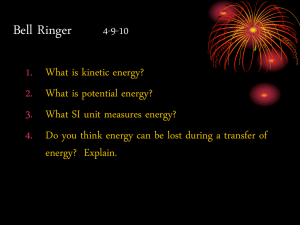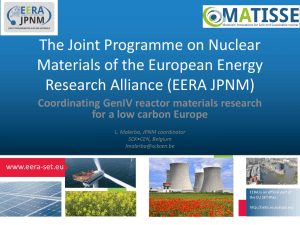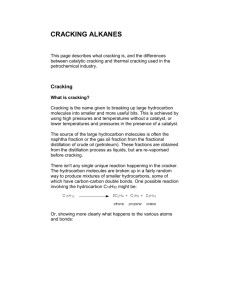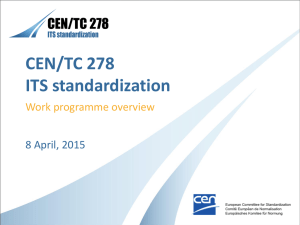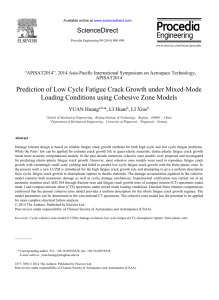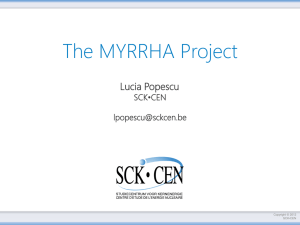MATTINO/Activities on Nuclear Materials Research
advertisement
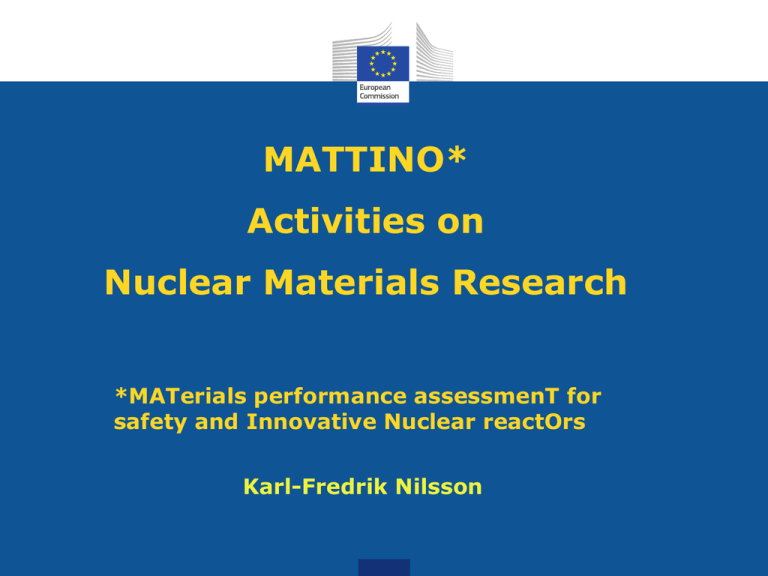
MATTINO* Activities on Nuclear Materials Research *MATerials performance assessmenT for safety and Innovative Nuclear reactOrs Karl-Fredrik Nilsson Our Main mission is Materials and components related safety issues for present and future reactors Standardisation Increased emphasis Safety reference Basic research into materials performance characterisation Modelling & Simulation SNETP: The 3 Pillars SNETP is central for our activities NC2I NUGENIA ESNII, EERA JPNM NUGENIA: Maintain safety and competitiveness of today’s technologies NC2I: Enlarge nuclear fission portfolio beyond electricity production (heat) ESNII/EERA JPNM: Develop Gen IV Fast Reactors with closed fuel cycle to enhance sustainability and to minimize waste Examples of Activities 1. Experimental Activities • • Stress corrosion cracking Small Punch Test 2. Experimental and modelling • • Thermal Fatigue of pipes Residual stresses in welds 3. Model development • • Multi-scale and physics based models Simulation of fuel cladding in accident scenario 4. Codes, Standards & Harmonization • • European Design Codes Materials Database MatDB Stress Corrosion Cracking (AMALIA) Why? irradiation damage damage interaction thermo-mech. loading chemical attack Stress corrosion cracking is one of the major failure mechanism in power plants need for environmental testing incl. in-pile experiments, collaboration with VTT, ITU, NRG, CV Rez 3 recirculation loops with full water chemistry control, equipped for environmental mechanical tests at pmax = 360 bar, Tmax = 650°C: => BWR, PWR, SCWR conditions Under construction: Liquid lead recirculation loop for - Corrosion - Erosion - Stress corrosion cracking At Tmax = 700°C, vmax = 5 m/s Small Punch Test Why? Need for fast “semi non-destructive ” test method for small specimen • • • Possibility to obtain creep resistance data from small amounts of material Characterization of material response to multi-axial loading Characterization of anisotropy in mechanical properties SP test specimen, 8mm diameter, 0.5 mm thickness Main principle of small punch test SP creep tests were carried out in accord with the CWA 15627 Code of Practice, at 650°C in an Ar atmosphere. Application to P91 weld INTEGRITY of repair welds Project 4-point bend (75.89 kN) + internal pressure (160 bar) at 600 °C for 5000 h INTEGRITY Pipe BM - Base material WM - Weld material HAZ material: (FG Fine grained, CG Coarse grained) SE - Service exposed* * Service exposed conditions: 60kh at 565 oC under pressure of 250 bar Application to P91 weld • The weakest zone is clearly the fine grain HAZ where type IV cracking often occurs in plant components SP stress rupture results for all weldment zones Thermal Fatigue in Nuclear Components Why? Thermal fatigue is one of the major degradation mechanisms. Complex loadings is a main issue. • Procedures for thermal fatigue initiation (NESC) and propagation (NUGENIA) by replacing the load spectrum with the single frequency load that gives the shortest life • Experimental Programme to simulate thermal fatigue damage through cyclic down shocks Experimental set-up for Thermal fatigue tests Axial loading train Water quenching lines • Thermal loads: Induction Heating and cooling by water • Mechanical Load: Axial load (0, 50, 100 kN) Thermal Fatigue in Nuclear Components The initiation of cracking and depth of cracks is monitored by NDT Computed and measured crack depth vs # of cycles for 300°C and 550°C 15 Hut&Picker 550 C 14 Replica technique for crack initiation (surface cracking) crack depth, mm 12 10 8 Hut&Picker 300 C 6 4 2 Time-of-Flight Diffraction for crack sizing 0 0 0.5 1 1.5 cycles, N 2 2.5 3 5 x 10 Residual Stresses in welds Why? Welds are weak spots in components. For assessment we need to know: • Residual stresses • Material variability and defects Measured vs. computed • In MATTINO we perform: • Residual stress measurements with neutron diffraction and synchrotron diffraction • Analyses with different levels of refinement Initial Spiral slit technique in synchrotron diffraction stress measurement: Refined Research Front: Multi-scale Models (Crystal plasticity models) Why? • Material degradation occurs at different “length and size scales” • Necessary to extrapolate form accelerated tests to operational conditions • Basis for development of new materials (e.g. nano materials) Fatigue initiation and short crack growth Dislocation patterning IGSCC-Multiscale modelling • Surface reconstruction Real grain topology Simplification • Conformal meshing: Surfaces Volumes • Constitutive models: Grains: AE+CP Grain boundaries: cohesive zone Experimental data University of Manchester: http://dx.doi.org/10.1016/j.commatsci.2010.12.014 13 April 2015 14 Model development • New Model development & implementation in Codes • Strain gradient effects • Non-convex free energy (leads to instabilities) • Grain boundary model 10 10-1 10-3 Computed variation in stress-strain curves for different loading rates caused by dislocation patterning Patterning from non-convexity Fuel pellet clad interaction (sub-assembly blockage) Why? Fuel cladding is the first safety barrier. Safety assessment requires modelling of the fuel and cladding for relevant loads • Assessment of the behaviour of fuel pin sub-assembly blockage (GFR) • Two-step analysis: Von Mises stress distribution in fuel and cladding 13 April 2015 • CFD temperature transients • FEM fuel-pin (cracked fuel and cladding) Computed hoop strain cladding Computed K vs. crack depth (different crack aspect ratios) 16 Contribution to Codes & Standards Examples: • Code of Practice Small punch test (CEN/CENEL) • European Procedure HighCycle Thermal Fatigue (NESC/NULIFE) • Design & Construction Code for mechanical Equipment of innovative nuclear installations (CEN/CELEC) • Feasibility Study to develop standardized rules for the design and construction of Gen IV reactors (DG-ENER) MATTER Project • 7th Framework EURATOM project • Development of Test procedures and Design Rules in support of Design & Construction of ESNII Reactors • Three Domains • D1: Screening Test procedures and material characterization tests for MYRRHA • D2: Design Rules for ASTRID, Gr 91 steel (creep-fatigue, ratchetting, negligible creep, welding, thermal ageing..) • D3: Management of EERA JPNM Workshop on Env. Degradation effects & Design Codes for heavy liquid metal reactors In the MATTER Description of Work • Original idea: presentation of progress in MATTER Design Code related Work Packages (WP 4 – 6) (high-temperature issues) • More urgent need to discuss Design Rules for heavy liquid metal alloys (CEN WS/64 Feasibility Study) When; Second Quarter 2013 Where: Petten Duration 1,5 days MATTER WS HLM Env. Degradation & Design Codes Topics to be addressed: • Design and material and component requirements for ALFRED and MYRRHA (partly already covered by MATTER Deliverable and last year's Workshop) • Degradation mechanisms for lead and lead-bismuth • Mitigation mechanisms (coatings, environment control, etc) • Requirements/needs for environmental degradation sections in Design Code (RCC-MRx as basis) (e.g. priorities of specific data) • Proposal for outline of Design Factors and structure of Design Code for HLM environmental effects Who should attend? • Experts in environmental degradation HLM • Reactor Designers • User and developers of Codes • Generalists in environmental effects & Design Codes Confirmed participation (ALFRED/MYRRHA Development ESNII): ENEA, KIT, KTH, SCK•CEN, JRC, NRG?, ANSALDO? Confirmed participation (Design Code): RCC-MRX/AREVA Confirmed participation: D. Tice (AMEC, ASME and LWR) Invitation sent: (IPPE/Obninsk) Exact Dates not fixed: main reason waiting for response from IPPE MatDB—Overview • MatDB is an online database application for preserving and exchanging engineering alloys data • The facility is based on an enduring data model established more than 30 years ago through the joint efforts of NIMS, NIST, and the JRC Material entity Chemical composition Designation & production Characterisation Isotropic grain size Duplex grain size Directionally solidified grain size Hardness Microstructure Phase Physical constants Thermo-mechanical heat treatment Customer internals MatDB—Purpose • Support to nuclear safety policy • IAEA embrittlement data • Safeguard data • Data relevant to MYRRHA from former FBR and HTR research programmes • Support to Euratom indirect actions • Data management • Data exchange • Reuse • Development of new testing Standards, such as creep-fatigue and small punch • Validation of models • MatDB—Activities • I-NERI Materials Database Interoperability project • Enable data transfer between MatDB and the GenIV Handbook hosted at ORNL • Migration of the IAEA Surveillance Database • Transfer more than 40.000 data sets to the IET materials database • Development of ICT Standards for database interoperability • Enable systems interoperability in the engineering materials sector by developing Standard messaging formats for data transfer • Work performed in the framework of the European Committee for Standardization (CEN), IET awarded lead role in CEN/WS SERES, a 2-year CEN Workshop on Standards for electronic reporting in the engineering sector • Data citation • Data cite DOIs assigned to individual data sets to allow citation and reuse




